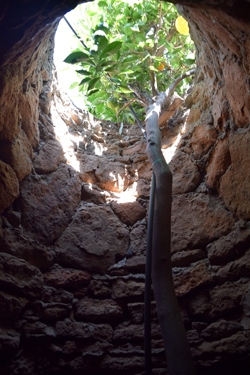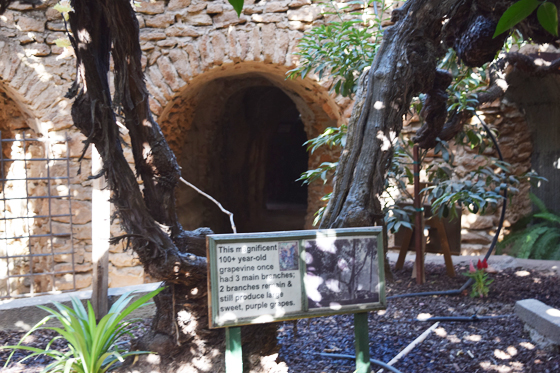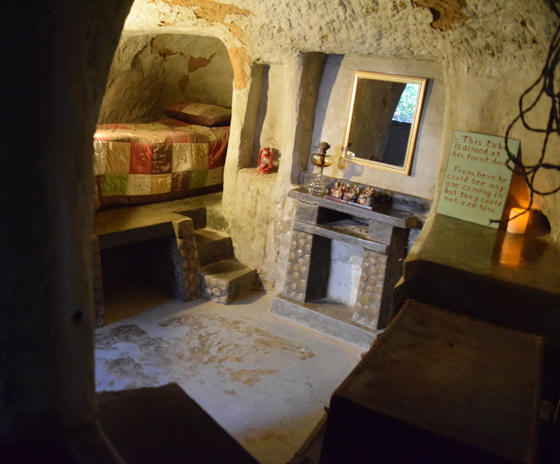Editor’s Note: Traveling by car between San Diego and the San Francisco Bay area where their son and three grandchildren are domiciled, co-publishers Don & Nancy Harrison like to explore California’s cultural attractions.
-Last in a Series –


FRESNO, California – In Western religions, the numbers 3, 7, and 40 have symbolic significance. So too are they important to the understanding of the life and works of Baldassare Forestiere, who created the sprawling underground gardens and home that today are recognized as a California Historical Landmark as well as a venue listed on the National Register of Historic Places.
Forestiere, born in 1879, immigrated to the United States from Sicily in 1901, settling first in New York City where he worked as a laborer on the Holland Tunnel, through which cars pass under the Hudson River between New York City and Jersey City. In 1904, he moved to California, initially planning to purchase land in Orange County. But when that proved too expensive, he moved north to the San Joaquin Valley, purchasing 80 acres in Fresno.

However, beneath the top soil of his hoped-for citrus groves lay hard layers of sedimentary rock, known as hardpan, totally unsuitable as a bed for acres of trees. That was not Forestiere’s only disappointment; he learned to his dismay that summers in Fresno can get very hot, with temperatures in excess of 115 degrees not uncommon.
And thus began the story of the remarkable underground gardens. While he supported himself as a day laborer, Forestiere, a bachelor, had his evenings, early mornings, days off, and weekends to experiment with the skills he had learned while tunneling under the Hudson River. Using simple tools, he began to dig, and to scrape, and to hollow, until he was able to fashion a room that was mostly under the ground, save for air vents and sky lights. He constructed arched entrances and passages to other rooms in a little-by-little process in which he took advantage of a variety of recycled material to shore up ceilings, patch holes, and add decorative touches to his underground warren.
In this underground home, the temperatures were as much as 15 to 20 degrees cooler – an incentive for Forestiere to keep expanding the project to some 50 rooms spread over the 10-acre property. However, much of this land was sold by subsequent generations, so that today the underground creation has been reduced to 15 rooms over 2 ½ acres with an additional acre currently in various stages of renovation by members of the Forestiere family.

Being a religious Roman Catholic, Forestiere often honored the Trinity – God, Jesus, and the Holy Spirit – utilizing threesomes in various venues of his home. Three alcoves with citrus trees are part of a passageway next to his home. In the Chapel Garden similarly there are three trees. The Trinity Courtyard features three benches in a three-foot high planter. The aquarium was built in a three-level enclosure, permitting visitors to watch the fish from different elevations.
Another important design feature was the number seven—honoring the six days of creation and the seventh day of rest, according to our guide Latieshka Simmons. Among the most notable instances of the number seven amid arches and stairwells was a citrus tree onto which Foresteire grafted seven kinds of fruit, of which only two varieties of oranges still grow today. One of the fruits he grew was the citron, known as an etrog in Hebrew, which is one of the four species observant Jews wave in multiple directions during the holiday of Sukkot.

So, there we have the numbers of 3 and 7, but what about 40.
Like the biblical accounts of 40-days of rain covering the world during Noah’s time and the 40 years of wandering in the desert in the era of Moses, Forestiere worked on his project for 40 years, from 1906 to 1946, the year he died on November 10.
The gardens are located at 5021 W. Shaw Avenue in Fresno. The underground gardens are open Wednesdays through Sundays in April through November. Ticket information and directions may be accessed via this website. www.undergroundgardens.com
*
Donald H. Harrison is editor of San Diego Jewish World He may be contacted via donald.harrison@sdjewishworld.com